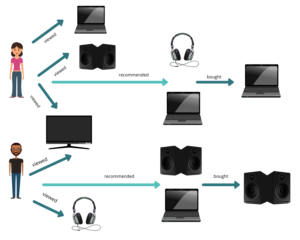Personalized product recommendations are currently one of the most important trends in the e-commerce market. Based on the technology of artificial intelligence and machine learning, the recommendation engine is able to generate lists of recommended products tailored to each user in real-time.
In this article, we will try to answer the question of how recommendations work and how they increase sales. You will also learn how to install our personalized recommendation system, Recostream, in an online store on Shopify.
How do purchase recommendations work?
The operation of a modern product recommendation engine is based on collecting information on the behavior and shopping preferences of the current user and comparing them with the behavior of previous customers. A machine learning algorithm displays to store visitors’ lists of products that are most likely to be purchased. The entire process relies on an advanced recommendation engine based on artificial intelligence, which analyzes the collected data in order to look for dependencies and connections. The operation of the recommendation engine is presented in the following diagram.

Personalization is king! Why is it worth creating unique shopping experiences?
What are the effects of implementing the system of personalized purchase recommendations?
Measuring the effectiveness of the recommendation engine through statistics provided by external tools may turn out to be unreliable. Fortunately, there is a solution for this. The key to objective verification of sales results thanks to recommendations is the integration of the engine with Google Analytics.
The Recostream system has a functionality that allows for easy connection with a GA account. Due to this option, the store manager can not only analyze the Recostream conversion data independently but also has access to other reports useful for the online store, including transaction summaries or data on product popularity. You can read about how to integrate the recommendation system with Google Analytics in this post.
The results of Recostream implementations in online stores indicate that within a week after installing the recommendation, you can expect a 5-10% increase in revenues. Thanks to the specificity of artificial intelligence algorithms, this indicator may increase with the gradual adaptation of the recommendation engine to the specificity of the product range and user behavior. The share of sales of products referred to in recommendations generally ranges between 5-20%.
What is the best place to implement a recommendation in an online store?
One of the most important factors in maximizing the benefits of recommendation engines is their location on the store page. It is worth adjusting the available models to the appearance of the website and integrating them in different places of the store for the best results. Here are some of the most important places and types of recommendations in the online store.
1. Recommendations on product pages
Product pages are the most popular and profitable place to put product recommendations in your e-commerce store. This is where users have access to specifications and photos. Placing a window with items that may be of interest to a given customer will make it easier to compare the product with other offers, and also simplify navigation through the store’s tabs.
2. Pop-up window on the shopping basket page
Placing a recommendation in a special pop-up window that the customer will see when going to their shopping basket can be a great way to implement up-selling strategies in your store. Models such as “other customers also bought” will present the user with other products that match the things one has chosen and create harmonious sets with them.
Considering that at this step there are users who have already made a purchase decision and are convinced to take advantage of the store’s offer, there is a high probability that they will be willing to add something else to the basket. The key to the success of this solution is that the pop-up does not interfere with the customer’s interaction with the store, does not spoil the overall impression of using the website and that matches the overall style of the online store.
3. Pop-up on the page of an unavailable product
How to keep the consumer on the store’s website when they find an unavailable product? This situation happens often, particularly after a period of pre-holiday shopping spree or mass Black Friday promotions. By placing a pop-up window on the page of an unavailable product, the user’s attention after clicking on an unavailable product will be redirected to similar recommended products. Thanks to this solution, the bounce rate will decrease.
4. Product recommendations on category pages
In most cases, customers viewing product category pages have a specific purpose for visiting a given online store. A good tactic is to use a model that presents users with the most popular products in a given category or in the entire store. This way, you will be able to attract the attention of potential customers and encourage them to stay on the store’s website.
5. Banners on the home page of the store
The home page is the first place that users who visit your site are going to see. It often happens that users are not looking for a specific product, but casually browse the store’s website. In such situations, it is worth displaying an offer that will attract their attention and encourage them to stay on the page and continue navigating. Displaying a recommendation banner here that includes bestsellers, news and promotions can be a great way to attract new customers.
On the other hand, for existing customers who return to the store’s website, it is worth displaying the “recently viewed” recommendation model, which reminds them about abandoned sessions and encourages to make a final purchase.
6. Product recommendations on the store’s blog
Before making the final purchase, a potential customer of the store has a habit of searching for the most reliable information about a given product and the opinions of other users. Bearing in mind that social proof is an important element of the shopping journey, it is worth opening a store’s blog to share expert knowledge about the products offered. The purchase recommendation engine, thanks to an advanced algorithm, knows which product (or a similar product) the blog entry is referring to and can automatically propose contextual recommendations in the banner in the content of blog posts.
How to install a system of personalized recommendations?
One of the biggest advantages of the personalized recommendation engine is the simple installation and integration process with the store. Neither technical expertise nor programmer’s help is needed. All you need to do is paste a Javascript code line on the store’s website.
Here’s how the recommendation engine installation process works with Recostream:
- Account creation – in order to start the process of integrating the recommendation engine with the online store, register on the Recostream website using your corporate e-mail address and entering the URL of the online store.
- Paste Javascript code – upon registration, an individual Javascript code will be generated, which will allow the system to connect to the store. You should paste the received code into the <head> section of your online store – the same way as in the case of integrating your website with Google Analytics. You can do it, for example, through Google Tag Manager or your store’s panel.
- System configuration – in the next step, the Recostream team will configure the system in a customized way so that the store’s customers can immediately enjoy the right recommendations (no “cold start” problem). Administrators have full access to information collected by cookies concerning website traffic, session history, information on products and their availability. This process takes one business day.
- Full access to the system – after starting the recommendation engine, a free 30-day trial period will begin, during which the store owner can test its operation. Thanks to the access to an intuitive dashboard, the store manager can constantly monitor the conversions generated due to recommendations and the value of products sold.
That is all there is to do. From now on, Recostream will independently collect and analyze information about website traffic and generate a list of recommended products based on it.
What do you think about recommendation systems in e-commerce?
In our opinion, intelligent recommendation systems are a great way to personalize the user experience on the website, and the statistics provided by Recostream show that this has an impact on increasing conversion. If you are interested in testing this system in your online store, use the free trial period on the Recostream website. We’d love to hear about your experiences with this system.


